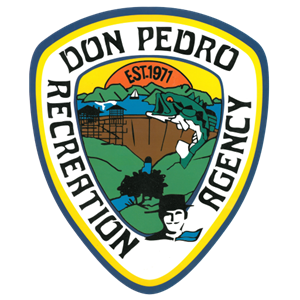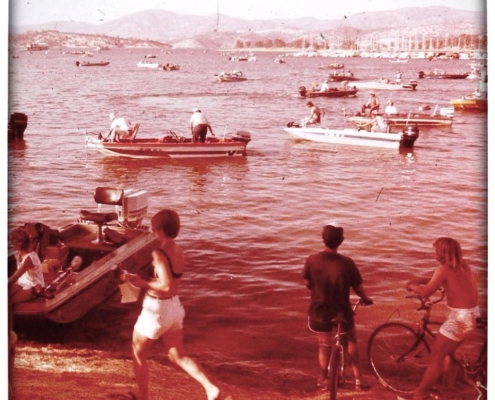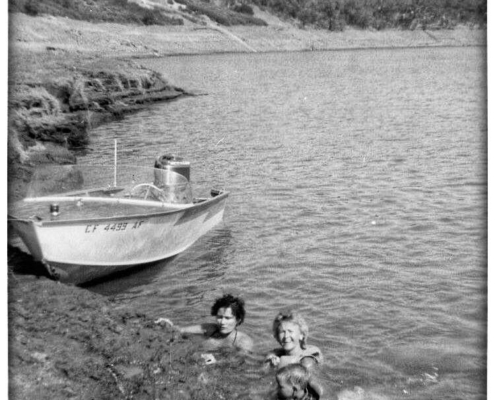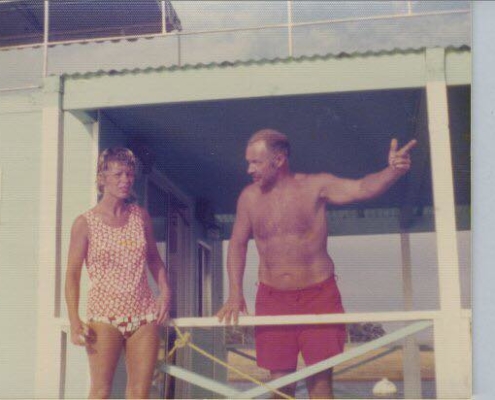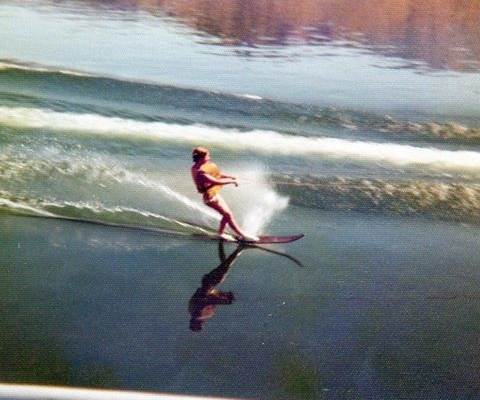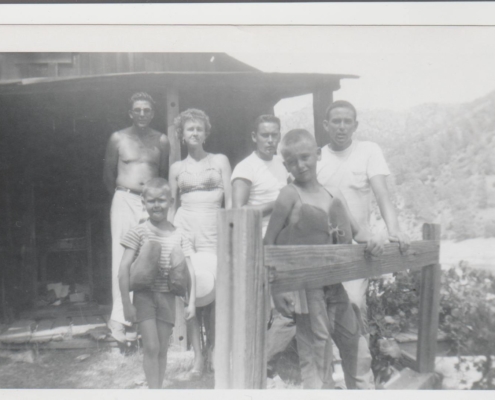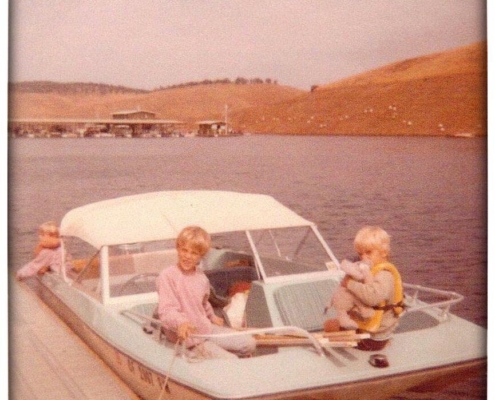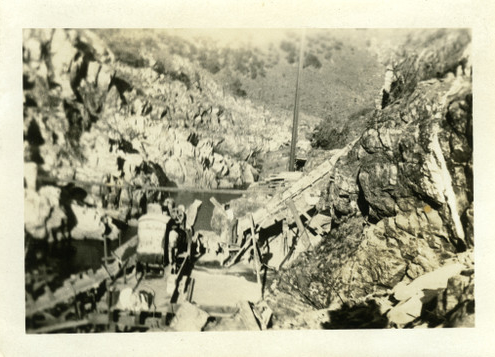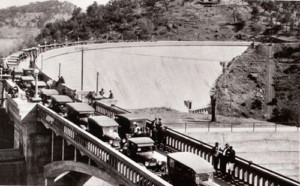Construction

Approved by DPRA Board of Control 2/10/06
The Turlock and Modesto irrigation districts completed the construction of the original Don Pedro Dam in 1923. With a storage capacity of 289,000-acre feet, it was barely able to accommodate the irrigation needs of a single growing season. After numerous dry winters, the Districts decided to replace the original dam with a much larger one in order to store the water necessary to bridge multiple dry years.
The City and County of San Francisco joined with the two irrigation districts in constructing what at the time was known as the New Don Pedro Project. The ‘New’ was formally dropped from its name after the old dam was inundated by the waters of the larger reservoir. Today, it is known simply as the Don Pedro Reservoir, Don Pedro Lake, or Lake Don Pedro.
In exchange for its financial contribution to the construction of the Project, San Francisco obtained relief from upstream flood control responsibility on the Tuolumne River and gained greater flexibility in its upstream operations. By virtue of a complex banking and accounting arrangement, San Francisco may pre-release water into Don Pedro where it becomes the property of the Districts. With a ‘credit’ in the Don Pedro water bank, San Francisco may then divert upstream flows to which the Districts would otherwise be entitled. This arrangement helps to conserve the waters of the Tuolumne and maximize their beneficial use. San Francisco does not own any portion of the Don Pedro Project or the water in the reservoir. It also does not physically divert any water from the reservoir into its water system.
Construction of the New Don Pedro Project began in 1967 and was completed four years later at a cost of $105 million. Built primarily to store irrigation water, the reservoir has a capacity of 2,030,000 acre-feet and has many additional benefits including power generation, flood control, and recreation. The old dam is still in place, 250 feet below the surface of the full reservoir.
Dam Statistics
The Don Pedro Recreation Agency, which is responsible for the recreation element of the Don Pedro Project, is sponsored by the Turlock Irrigation District, the Modesto Irrigation District, and the City and County of San Francisco.
- 580 Feet high
- 855 Feet above sea level at the crest
- 1900 Feet at crest length
- 40 Feet wide at the crest
- 2800 Feet wide at its base
Don Pedro – There Really Was One...........But He Was A Frenchman!
A prominent French pioneer has emerged from an obscure page of California history as the man for whom Don Pedro Dam is named. His name was Pierre Sainsevain.
Don Pedro? A Frenchman? Certainly, anyone who owned a rancho in early California was accorded the title of Don, and Pierre translates to Pedro in Spanish.
Sainsevain arrived in California on the ship Ayacucho in 1836. He was a twenty-year-old carpenter with a passport stamped in Bordeaux. His first adventures in the state are unrecorded, but by 1839 he had made his way to Los Angeles, where he joined his famous Uncle, Don Luis Del Aliso, in winemaking. He proved himself to be a very talented vintner and soon he loaded a ship with wines and sold them from port to port, up and down the California coast.
In 1843, Sainsevain was granted the Canada del Rincon rancho near Santa Cruz. He spoke no English, but was fluent in Spanish and easily met the requirements to receive land from the Mexican government. These requirements included his naturalization as a Mexican citizen.
In 1846, Sainsevain met up with fellow Frenchman, Charles Roussillon and together they built a schooner, opened a sawmill near Santa Cruz and a flour mill near San Jose.
Sainsevain and Roussillon met J.A. Moerenhout, the French consul at San Francisco and much of what is known of their gold rush experiences comes from Moerenhout’s recollections. Moerenhout had met both Frenchmen in San Jose, but he may have found their dust begrimed faces hard to recognize when he next met them in the mines near Coloma in July 1848.
“Their place was well chosen, a little stream of excellent clear water, but with their usual negligence there was not a tent and though they gave me a hearty welcome and, considering where we were, a good supper. I had again, as during all my journey from San Jose, to sleep on the earth and to have the stars for bed canopy,” he wrote.
“At daybreak, all was astir. Men were leaving on foot and on horseback, loaded with pickaxes, picks and shovels, some going to loosen and dig out the dirt, others to cart it. Hardly a soul remained in camp.”
Moerenhout remained a few days, and watched “Mssrs. Sunol, Sainsevain, Roussillon and Amador,” with help from twenty-five Indians, scratch up about 130 ounces of gold among them per day. Not far away Capt. Charles Weber, the founder of Stockton was camped on Weber Creek. Weber knew something about gold and suspected it could be found in other rivers of the Sierra Nevada, not just the American. He already had formed the Stockton Mining Company and had sent trained Indians into the Stanislaus and Tuolumne River regions to explore for gold.
In August, the Indians returned with good samples and Weber’s party started immediately for the new territories. He became the founder of the Southern Mines, San Joaquin County historian George H. Tinkham told the story this way in 1880:
“Accordingly, two men were left to close out the mercantile business and the company came back to French Camp (near Stockton) to prepare for the new field. With them others who had been mining in the same neighborhood came also.”
“After replenishing their stores the company started for the Stanislaus. Here they commenced prospecting in the streams and gulches, scattering in every direction.”
“The familiar names of Murphy’s Camp, Sonora (formerly Sonorian Camp), Angel’s Camp, Don Pedro’s (Sansevina) Bar (as it was commonly spelled), Sullivan’s Bar, Wood’s Creek, etc., are named after those men who started with the company and camped in those localities.”
Don Pedro Bar became one of the most famous gold mining towns and was known as a very rich strike, but Sainsevain did not stay there long, and neither did his real name. The Frenchmen Sainsevain and Roussillon soon had enough of mining and they returned to Stockton to open a store. Moerenhout found them there in August of 1849, selling wines, brandies, shirts, shoes, clothing and preserved fish and vegetables. They were doing a brisk business with the miners who were streaming by the thousands into California through Stockton for the goldfields.
Toward the end of 1855, Sansevain sold his rancho near Santa Cruz, and with his brother bought the Aliso vineyards in Los Angeles from their uncle, Jean Louis Vignes, Don Pedro gained fame in his own right as a vintner before he died in his native Bordeaux many years later.
While the historians soon took an interest in Sainsevain’s activities and recorded them, they tended to call the place Sainsevain Bar. The Don Pedro name was dropped, even by Tinkham who had used it in 1880. By 1923, a much older Tinkham was telling Weber’s story again in a history of San Joaquin County. He mentioned only “Sainsevain Bar,” omitting the Don Pedro.
In the locale of the bar, on the other hand, the name Don Pedro stuck while the name Sainsevain was forgotten. In 1923, the Modesto and Turlock Irrigation Districts built the tallest dam in the world and drowned out the famous gold site forever. The dam was named for the town, but no one remembered Sainsevain.
In 1971, a new and vastly larger dam was completed by the same irrigation districts and San Francisco, inundating the first dam entirely. It too was named Don Pedro Dam after the mining town.
